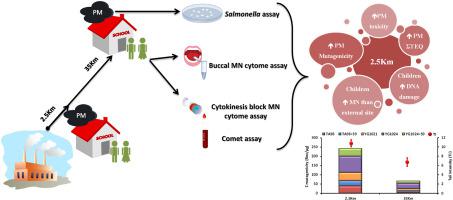Environmental Research ( IF 7.7 ) Pub Date : 2020-04-21 , DOI: 10.1016/j.envres.2020.109443 Andréia Torres Lemos 1 , Clarice Torres de Lemos 2 , Mariana Vieira Coronas 2 , Jéssica Rosiak da Rocha 2 , Vera Maria Ferrão Vargas 1

|
This study aimed to evaluate genotoxicity effects of inhalable particulate matter from areas influenced by a petrochemical complex on exposed children population. Peripheral blood and buccal mucosa exfoliated cells were collected from 54 children (5–12 years) at two public schools, 2.5 Km (Site NW) and 35 km (Site NWII) from the main industrial emission source. These areas lie in the first wind direction from a petrochemical complex. Blood samples were used to Comet Assay (CA) evaluating the tail intensity and to the cytokinesis-block micronucleus cytome assay (CBMN-cyt), assessing the frequency of micronucleus (MN), nuclear buds (NBUDs) and nucleoplasmic bridges (NPBs). Buccal micronucleus cytome assay (BMCyt) was used to detect MN and nuclear abnormalities. Mutagenicity of particulate matter (PM) organic extracts from these two sites, besides from one in the second wind direction (NE) was evaluated by Salmonella/microsome assay, microsuspension method, strains TA98, YG1021 and YG1024 with and without metabolic activation (S9). The site closest to the petrochemical complex (NW) presented worse air quality, evidenced by greater PM mutagenicity and more toxic PAHs profile (ΣTEQ). Also, Tail intensity was significantly higher at this site (10.65 ± 0.78) compared to site NWII (6.73 ± 0.92). MN frequencies in CBMN-cyt did not differ among groups, but was significantly higher than an external reference site. NBUDs were significantly higher at site NWII. BMCyt showed no difference among the groups for MNs and NBUDs. Site NWII showed higher frequencies of karyorrhexis and karyolysis. All samples, even within the PM limits, presented genotoxic potential. Results showed that the children are exposed to a mixture of contaminants from different sources, and that the proximity of the petrochemical industry gives a cause of concern. Actions must be taken to identify and reduce emissions and hazardous effects, since air quality standards are not enough to ensure the exposed population health.
中文翻译:

对中小学生遗传毒性生物标志物和石化影响地区可吸入颗粒物的综合研究。
这项研究旨在评估受石化复合物影响的地区的可吸入颗粒物对暴露的儿童人群的遗传毒性作用。从两所公立学校的54名儿童(5至12岁)收集了外周血和颊黏膜剥落的细胞,距离主要工业排放源2.5公里(西北站点)和35公里(西北站点)。这些区域位于石化联合体的第一个风向。血液样本用于彗星分析(CA)评估尾巴强度,并用于胞质分裂阻滞微核细胞计数(CBMN-cyt),评估微核(MN),核芽(NBUDs)和核质桥(NPBs)的频率。颊微核细胞计数法(BMCyt)用于检测MN和核异常。来自这两个位置的颗粒物(PM)有机提取物的致突变性,沙门氏菌/微粒体测定法,微悬浮法,带有和不带有代谢激活的菌株TA98,YG1021和YG1024(S9)。最接近石化厂(NW)的地点空气质量较差,这可由更高的PM致突变性和更高毒性的PAHs谱(ΣTEQ)证明。而且,与NWII站点(6.73±0.92)相比,该站点的尾巴强度显着更高(10.65±0.78)。CBMN-cyt中的MN频率在各组之间没有差异,但显着高于外部参考位点。NWII站点的NBUD明显更高。BMCyt在MNs和NBUDs组之间没有差异。NWII站点显示出较高的出核率和溶核率。即使在PM限度内,所有样品均具有潜在的遗传毒性。结果表明,儿童暴露于来自不同来源的污染物的混合物中,以及石化行业的临近引起人们的关注。由于空气质量标准不足以确保裸露的人群健康,因此必须采取措施识别并减少排放和有害影响。











































 京公网安备 11010802027423号
京公网安备 11010802027423号